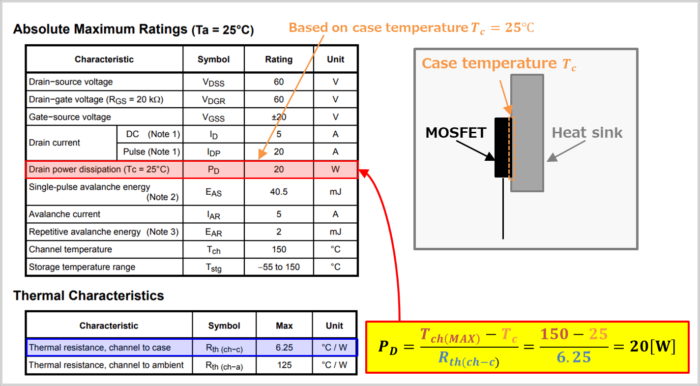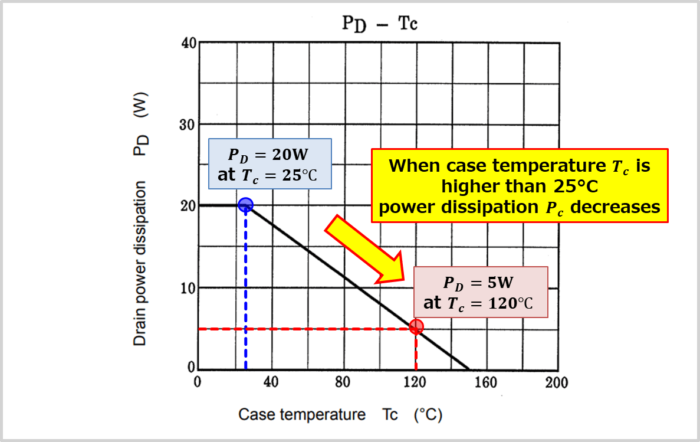Regarding the "Power Dissipation \(P_D\) of MOSFET", this article will explain the information below.
- Power Dissipation \(P_D\) of MOSFET
- \(P_D\)-\(T_c\) Characteristics of MOSFET
Power Dissipation of MOSFET

The power dissipation \(P_D\) of a MOSFET is the power dissipated when the channel temperature \(T_{ch}\) reaches the absolute maximum rating.
The symbol for power dissipation depends on the datasheet, but it is often expressed as \(P_D\), \(P_d\), \(P_T\), \(P_{tot}\), or \(P\).
In the case of "packages to which a heat sink can be attached such as TO-220" or "packages that allow backside heat dissipation such as TO-252", the power dissipation \(P_D\) listed in the datasheet is based on "case temperature \(T_c=25\mathrm{^{\circ}C}\).
Therefore, the power consumption when the case temperature \(T_c\) reaches the absolute maximum channel temperature rating \(T_{ch(MAX)}\) from 25°C is the power dissipation \(P_D\) listed on the datasheet.
The power dissipation \(P_D\) is expressed by the following equation using the thermal resistance \(R_{th(ch-c)}\).
Power Dissipation Formula
\begin{eqnarray}
P_{D}=\frac{T_{ch(MAX)}-T_c}{R_{th(ch-c)}}=\frac{T_{ch(MAX)}-25{\mathrm{[{^{\circ}C}]}}}{R_{th(ch-c)}}\tag{1}
\end{eqnarray}
The figure above shows the absolute maximum ratings and thermal resistance characteristics of a Toshiba N-channel MOSFET (2SK4017).
The absolute maximum channel temperature rating \(T_{ch(MAX)}\) and channel-to-case thermal resistance \(R_{th(ch-c)}\) listed in the data sheet can be confirmed to be the following values.
- Absolute maximum channel temperature rating \(T_{ch(MAX)}=150{\mathrm{[{^{\circ}C}]}}\)
- Channel-to-case thermal resistance \(R_{th(ch-c)}=6.25{\mathrm{[{^{\circ}C}/W]}}\)
Substituting the above values into equation (1), we obtain the following value for the power dissipation \(P_D\), which is consistent with the power dissipation \(P_D\) value listed on the data sheet.
\begin{eqnarray}
P_{D}&=&\frac{T_{ch(MAX)}-25{\mathrm{[{^{\circ}C}]}}}{R_{th(ch-c)}}\\
\\
&=&\frac{150{\mathrm{[{^{\circ}C}]}}-25{\mathrm{[{^{\circ}C}]}}}{6.25{\mathrm{[{^{\circ}C}/W]}}}\\
\\
&=&20{\mathrm{[W]}}\tag{2}
\end{eqnarray}
The data sheet also shows the thermal resistance \(R_{th(ch-a)}\) between the channel and the ambient. The thermal resistance \(R_{th(ch-a)}\) between the channel and the ambient shown in the data sheet can be confirmed to be the following value.
- Thermal resistance between the channel and the ambient \(R_{th(ch-a)}=125{\mathrm{[{^{\circ}C}/W]}}\)
Substituting the above values into equation (1), we can obtain the power dissipation \(P_D\) with no heat sink attached.
\begin{eqnarray}
P_{D}&=&\frac{T_{ch(MAX)}-25{\mathrm{[{^{\circ}C}]}}}{R_{th(ch-a)}}\\
\\
&=&\frac{150{\mathrm{[{^{\circ}C}]}}-25{\mathrm{[{^{\circ}C}]}}}{125{\mathrm{[{^{\circ}C}/W]}}}\\
\\
&=&1{\mathrm{[W]}}\tag{3}
\end{eqnarray}
If no heat sink is installed, this means that the channel temperature will reach 150°C with only 1[W] of power consumption.
Supplement
- Note that in the case of chip components, the power dissipation varies depending on the mounting board.
PD-Tc Characteristics of MOSFET

The power dissipation \(P_D\) listed on the datasheet is based on the case temperature \(T_c=25\mathrm{^{\circ}C}\). Therefore, if the temperature is higher than \(T_c=25\mathrm{^{\circ}C}\), the power dissipation \(P_D\) will decrease. The \(P_D\)-\(T_c\) characteristics (power derating curve) showing the relationship between power dissipation \(P_D\) and case temperature \(T_c\) is shown on the datasheet.
The above figure shows the "\(P_D\)-\(T_c\) characteristics (power derating curve)" of a Toshiba N-channel MOSFET (2SK4017).
When the case temperature \(T_c\) is 25°C, the allowable power dissipation \(P_D\) is 20 W. However, when the case temperature \(T_c\) is higher than 25°C, the allowable power dissipation \(P_D\) decreases. For example, when the case temperature \(T_c\) is 120°C, the allowable loss \(P_D\) is about 5W.
Therefore, the power dissipation \(P_D\) must be reduced to match the case temperature \(T_c\).
It is also possible to obtain the power dissipation \(P_D\) for each case temperature using equation (1). Substituting the case temperature \(T_c=25\mathrm{^{\circ}C}\) into equation (1), the following value is obtained, which can be confirmed to be the value in the "\(P_D\)-\(T_c\) characteristics (power derating curve)".
\begin{eqnarray}
P_{D}=\frac{T_{ch(MAX)}-T_c}{R_{th(ch-c)}}=\frac{150{\mathrm{[{^{\circ}C}]}}-120{\mathrm{[{^{\circ}C}]}}}{6.25{\mathrm{[{^{\circ}C}/W]}}}=4.8{\mathrm{[W]}}{\;}{\approx}{\;}5{\mathrm{[W]}}\tag{4}
\end{eqnarray}
Summary
In this article, the following information on the "Power Dissipation \(P_D\) of MOSFET" was explained.
- Power Dissipation \(P_D\) of MOSFET
- \(P_D\)-\(T_c\) Characteristics of MOSFET
Thank you for reading.